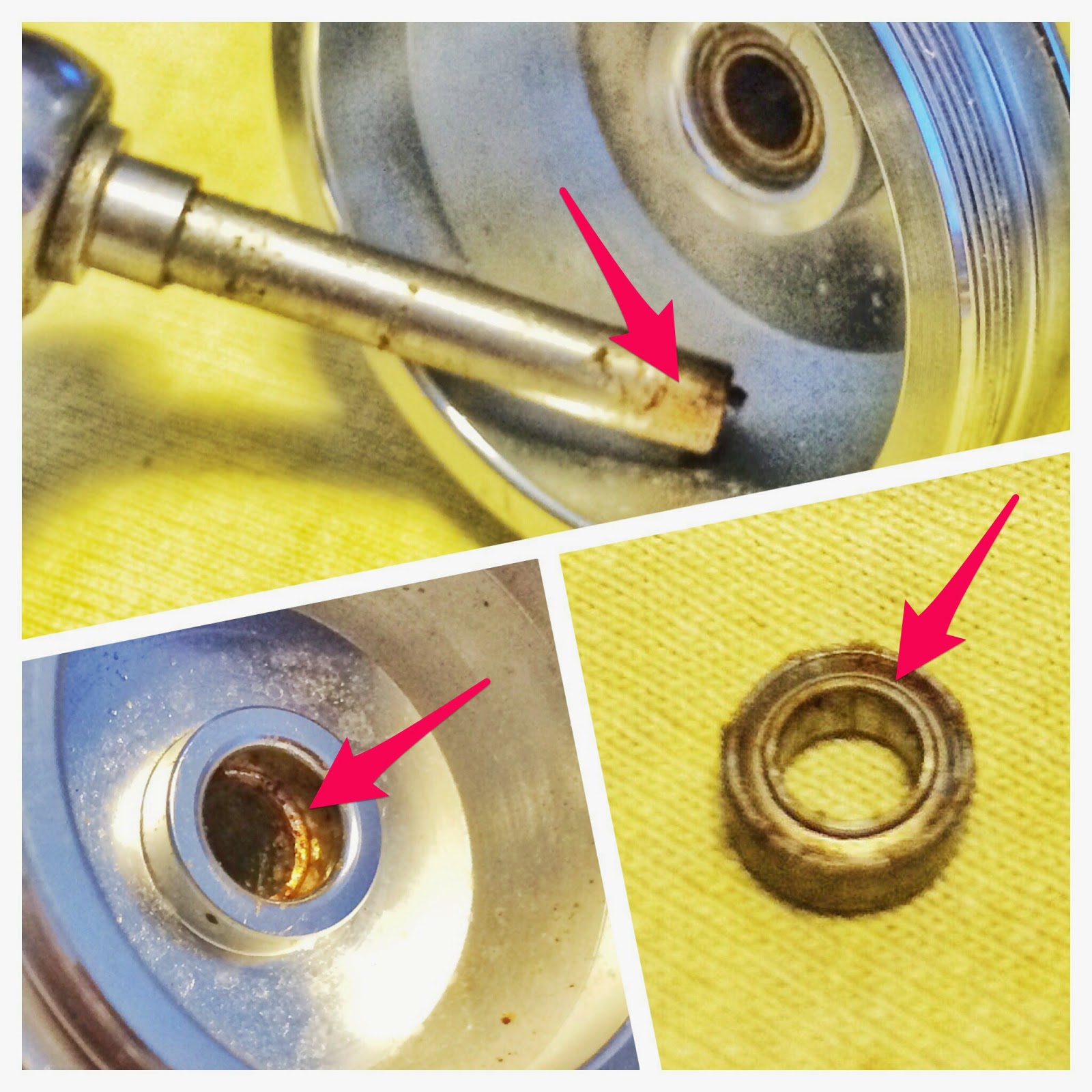Mr. Rusty strikes back! This reel knob
was apparently acting wobbly weird and the line roller wasn't even spinning. The victim in this case is a pimped up Daiwa Certate and it's time for a strip search!
 |
| Mr. Rusty left something unpleasant on this reel. We'll soon find out what and where. |
First
thing that was taken apart was the pimped up handle and knob. No rocket
science, just a cap and a screw in the way of revealing the unpleasant
gift from Mr. Rusty.
 |
| Knob
slides off and behold! Mr. Rusty left an explosive dump here. Rust
looked to have eaten up quite a bit out of the inner bearings most exposed to salt
water, which is still stuck on the shaft as pictured. Bearing shield came off and that's a really bad case of rust and
corrosion. The outer bearing seems perfectly fine. |
The
knob bearing closest to the handle seem to have exploded and grinded
some of its own bits into the the potpourri of shield, balls, races to
dust and rust.
 |
| It
took quite a bit of time and rust remover to work deep into the
corroded parts in order to dislodge the fused inner bearing race (blue
arrow) on the shaft. Thoroughly chewed up shields (green) and busted
balls (pink) only fell apart after rust remover seeped through the
entire pile of rust over a period of time. |
Mr.
Rusty left some nasty scars of corroded pits on the shaft but isn't
critical. All it needs now is a new bearing and proper coating of marine
grease packed into the entire assembly.
 |
| New bearings being loaded with marine grease before fitment back into the handle shaft. Existing outer bearing cleaned and greased too. |
Next
up, line laying roller refused to spin. Screw removal was a little
difficult too, I suspect it's overly enthusiastic thread locker used
here as the screw is usually made of marine grade stainless steel that
can withstand salt water corrosion without breaking any sweat.
The shaft's aluminum, pretty much corrosion resistant.
 |
| Thread
locker (red arrow) was found everywhere in the line roller shaft,
including the inside of the bearing (white and red powdered stuff).
Really bad stuff to be found in bearings. There seem to have a bit of
rust but mostly jammed up thread locker's preventing the bearings to
spin freely. It's causing quite a bit of challenge to remove the entire
assembly as it's as good as fused together with so much thread locker
everywhere. Luckily, after cleaning, the bearing seem to work fine only
with slight roughness. |
Cleaning of the line
roller assembly was a little tricky as you need to physically remove the
solidified material between tight creases like screw threads and worse
of all, inside the bearings. This calls for steel bristle brushing and
also good amounts of contact cleaner to remove any oily residue so that
new marine grease could be packed into the entire assembly.
The
remainder of the reel service was child's play after the above fiasco.
Just a quick cleaning and new application of marine grease is all it
needs. The only thing to be careful would be to avoid messing up the
magseal.
 |
| Floating
shaft & spool seat sleeve looked well used, still plenty of grease,
no damages found. Cleaned, greased and good to go. |
Avoid
the magseal and you'll be left with just the gear box to deal with. You
don't even need to mess with the one-way bearing. That's if it's
spinning smooth and stopping without play.
 |
| Gearbox
looks good, dry and like new. Just a quick clean up, wear and tear check, and add a fresh coat of marine grease. Nothing out of the ordinary and it's good
to go. |
The crack shaft bearing on the handle side seems a bit rough and a simple 2 step clean up with new grease packed in would do just fine. A 2 step clean up usually involves degreasing & contact cleaning after in order to replace lubrication in the bearing. Tougher grime or gunk would need the 3rd step involving an ultrasonic cleaning bath for a thorough cleaning.
 |
| No rust, but some light dust or gunk might have snugged in. Out goes the dirty grease and in goes new marine grease. |
What have we learned today?
1.
Go easy on the thread locker. What I usually do is use a small 'precision
screw driver' to dip into the thread locker bottle/nozzle and then dab
it over a few spots on screws. I don't even coat the entire screw. If
too much was accidentally applied, just clean it off with paper
towel before it dries. It doesn't even need to be reapplied upon next removal
or the next, it stays there long enough to hold the screw from coming
off. I only see a need for reapplication when there is absolutely no
friction when removing the screw.
 |
| Steel brushed existing screw to strip off old thread locker gunk (white arrow). Light dabs of new thread locker and rub it around just a little towards the tip (red arrow). |
2. Mr. Rusty can cause explosive
damages to bearings if left unattended for too long. Early detection is
key to stopping Mr. Rusty leaving unwanted gifts for your reel. Or
you'll have an excuse to pimp it up with exotic parts.










































